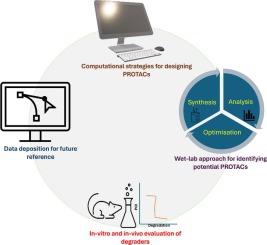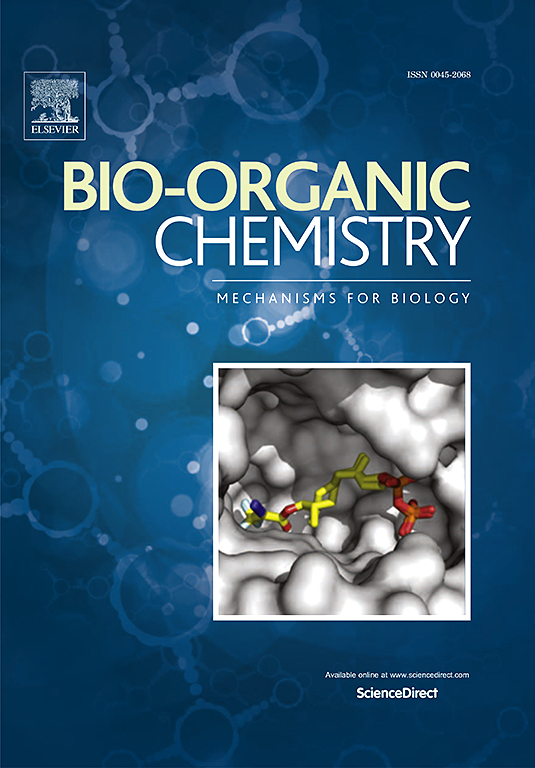Advances in designing ternary complexes: Integrating in-silico and biochemical methods for PROTAC optimisation in target protein degradation
IF 4.5
2区 医学
Q1 BIOCHEMISTRY & MOLECULAR BIOLOGY
引用次数: 0
Abstract
Target protein degradation (TPD) is an emerging approach to mitigate disease-causing proteins. TPD contains several strategies, and one of the strategies that gained immersive importance in recent times is Proteolysis Targeting Chimeras (PROTACs); the PROTACs recruit small molecules to induce the poly-ubiquitination of disease-causing protein by hijacking the ubiquitin–proteasome system (UPS) by bringing the E3 ligase and protein of interest (POI) into appropriate proximity. The steps involved in designing and evaluating the PROTACs remain critical in optimising the PROTACs to degrade the POI. It is observed that using in-silico and biochemical methods to study the ternary complexes (TCs) of the POI-PROTAC-E3 ligase is essential to understanding the structural activity, cooperativity, and stability of formed TCs. A better understanding of the above-mentioned leads to an appropriate rationale for designing the PROTACs targeting the disease-causing proteins. In this review, we tried to summarise the approaches used to design the ternary complexes, i.e., in-silico and in-vitro methods, to understand the behaviour of the PROTAC-induced ternary complexes.

设计三元复合物的进展:在目标蛋白质降解过程中,整合用于 PROTAC 优化的室内和生物化学方法。
靶蛋白降解(TPD)是缓解致病蛋白的一种新兴方法。靶蛋白降解包含多种策略,其中一种在近代受到广泛重视的策略是蛋白水解靶向嵌合体(PROTACs);PROTACs通过劫持泛素-蛋白酶体系统(UPS),使E3连接酶和相关蛋白(POI)适当接近,从而招募小分子来诱导致病蛋白的多泛素化。设计和评估 PROTACs 所涉及的步骤对于优化 PROTACs 以降解 POI 仍然至关重要。据观察,使用硅学和生物化学方法研究 POI-PROTAC-E3 连接酶的三元复合物(TCs)对于了解所形成的 TCs 的结构活性、合作性和稳定性至关重要。对上述问题有了更好的了解,就能为设计针对致病蛋白的 PROTAC 提供适当的依据。在这篇综述中,我们试图总结用于设计三元复合物的方法,即体内和体外方法,以了解 PROTAC 诱导的三元复合物的行为。
本文章由计算机程序翻译,如有差异,请以英文原文为准。
求助全文
约1分钟内获得全文
求助全文
来源期刊

Bioorganic Chemistry
生物-生化与分子生物学
CiteScore
9.70
自引率
3.90%
发文量
679
审稿时长
31 days
期刊介绍:
Bioorganic Chemistry publishes research that addresses biological questions at the molecular level, using organic chemistry and principles of physical organic chemistry. The scope of the journal covers a range of topics at the organic chemistry-biology interface, including: enzyme catalysis, biotransformation and enzyme inhibition; nucleic acids chemistry; medicinal chemistry; natural product chemistry, natural product synthesis and natural product biosynthesis; antimicrobial agents; lipid and peptide chemistry; biophysical chemistry; biological probes; bio-orthogonal chemistry and biomimetic chemistry.
For manuscripts dealing with synthetic bioactive compounds, the Journal requires that the molecular target of the compounds described must be known, and must be demonstrated experimentally in the manuscript. For studies involving natural products, if the molecular target is unknown, some data beyond simple cell-based toxicity studies to provide insight into the mechanism of action is required. Studies supported by molecular docking are welcome, but must be supported by experimental data. The Journal does not consider manuscripts that are purely theoretical or computational in nature.
The Journal publishes regular articles, short communications and reviews. Reviews are normally invited by Editors or Editorial Board members. Authors of unsolicited reviews should first contact an Editor or Editorial Board member to determine whether the proposed article is within the scope of the Journal.
 求助内容:
求助内容: 应助结果提醒方式:
应助结果提醒方式:


